Click on the images below for a bigger picture...
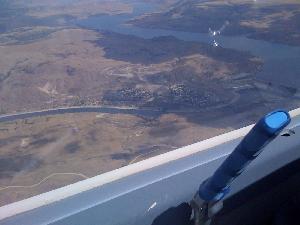
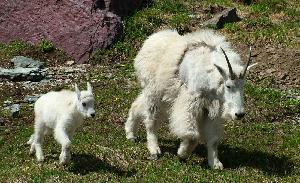
Participating in Oshkosh 2009 - EAA AirVenture
Updated Saturday, 10-October-2009
As a child, our neighbors took me to a local air show. I had seen the Disney flick on gliding, and was excited to hear the announcer discuss the impending arrival of a couple of gliders that were flying in from a nearby airport. I saw the Schweizer 1-26 and the gorgeous new Glasflugel Libelle arrive, and slipped under the crowd barrier to talk to the pilots and watch them disassemble their gliders.
I was hooked. Smitten. Done for. I knew that someday I'd fly these machines too. Years later a gliding club was a prerequisite for my choice of college, and so it was that I learned to fly with the MIT Soaring Association (MITSA), several decades ago.
Soaring has been a huge part of my life. I've now flown over 3,200 hours in gliders, mostly in contests. I'm lucky to have a magnificent Antares 20E, with which I can go fly huge distances without ever needing any ground assistance or a tow plane. In 2009 my longest flight was about 450 miles, with a total of over 7,500 miles logged cross-country in 33 flights, an average flight of 245 miles and 4:45 aloft, and always landing back home (using the Antares' electric motor to help return home only once).
As with most Soaring enthusiasts, I've tried to give a bit back our sport. The SN10 avionics package I designed with ILEC flies in twenty countries, from training operations (such as the US Air Force Academy) and clubs to top competition pilot's cockpits. With some friends I bought a Duo Discus two-seater, which we use to introduce people to Soaring and to show pilots a bit of cross-country (and that fiberglass gliders are not at all frightening). Our Duo was used by partner Juan Mandelbaum to make the classic film A Fine Week of Soaring, and partner Doug Jacobs uses it to teach cross-country soaring and raise funds for the USA national Soaring team.
I was flying my Antares 20E-18 in the USA 18-meter National Championships in Ephrata Washington when I got the message. "Would you exhibit your Antares at Oshkosh AirVenture as part of our electric aircraft theme?" What a great opportunity to promote Soaring ! EAA's AirVenture in Oshkosh is the biggest and best gathering of aviation enthusiasts on the planet. A mere quarter million aviation lovers attend from around the globe. Everyone in aviation is here - ultralights, warbirds, vintage planes, aerobatic planes and pilots, kit manufacturers, dreamers, seaplanes, production aircraft manufacturers, parts vendors, avionics, tools, trikes, helicopters - you name it and its at Oshkosh AirVenture - along with the people that deeply love flying.
Exhibiting the Antares could be great for both Soaring and promoting interest in electric aircraft. But, having the Antares sit idly in a hangar wouldn't have much impact. Seeing the Antares taxi, silently take off under its own power, retract the motor, fly by at 175 miles-per-hour while dropping water in 4 trailing plumes, gracefully pull up and fly a landing pattern, approach to land, then re-deploy the motor in flight and climb away at 800 fpm from just above the runway - now that makes an impression. I agreed to exhibit the Antares if EAA could arrange for me to fly it. Of course, most of the flying is arranged a year in advance. Regardless, after lots of phone calls and emails, I was scheduled to fly on Saturday (the biggest attendance day) and Sunday.
Steve Paavola of Greater Boston Soaring graciously volunteered to help with the drive and booth duty for the week. I arranged a discount on the SSA "FAST" introductory soaring package and Al Tyler was kind enough to match me; together we got the price down to $89 including S&H for our Oshkosh Intro Special. I drove back to Boston, spent a few days catching up with 6 weeks of accumulated mail and chores, then Steve and I headed back West with the Antares in tow. Amazing when a plan comes together at the last minute !
Making arrangements for Oshkosh AirVenture was very difficult while flying the nationals
and then vacationing with Renee in Glacier National Park.
Not much cell or wi-fi coverage up where theses critters roam.
Photos: Grand Coulee Dam (photo taken from the Antares while failing to
concentrate on racing during the nationals),
and mountain goats up at Logan Pass.
Click on the images below for a bigger picture...


This year's Aviation Learning Center featured two major themes - low-cost flying and electric aircraft. Exhibits in the Aviation Learning Center hangar included 5 electric aircraft, a half-dozen or so low-cost flyers, an alternative fuel development, plus two speaker presentation areas. There were several forums on electric aircraft - I presented an overview of the Antares 20E electric system and discussed the trade-offs taken.
Steve Paavola and I drove 1200 miles Saturday and Sunday, and then assembled the Antares and booth materials in the Learning Center late Sunday afternoon. The onslaught began at show opening on Monday morning. Anne Mongiovi, John Earlywine, and a number of other SSA'ers helped us set up and answered questions through-out the week. We had a steady stream of visitors, with only a few sporadic quiet times during airshow specials - and we too went outside to watch the Airbus A380 and White Knight Two perform. When it does get slow, running the Antares motor up and down always draws a crowd !
The range of visitors was vast: lapsed glider pilots, wannabees, power drop-outs, retired folks, really aviation lovers of all stripes. Many were interested in Soaring - especially the low cost as compared to powered flying. A surprising number of attendees were once active power pilots and stopped because of the cost, and thought they would go check out their local soaring site when we explained how inexpensive soaring can be. These are all prospective soaring pilots or tow pilots. I also met people from Australia with whom I had common friends, people I'd corresponded with from New Zealand - it is a truly international event.
Answering questions about Soaring and Antares at the display
inside the Aviation Learning Center.
The irony of exhibiting an Antares 20E next to the "Affordable Flying"
banner was widely appreciated.
Dave's back, Steve Paavola at left, photo by Anne Mongiovi.
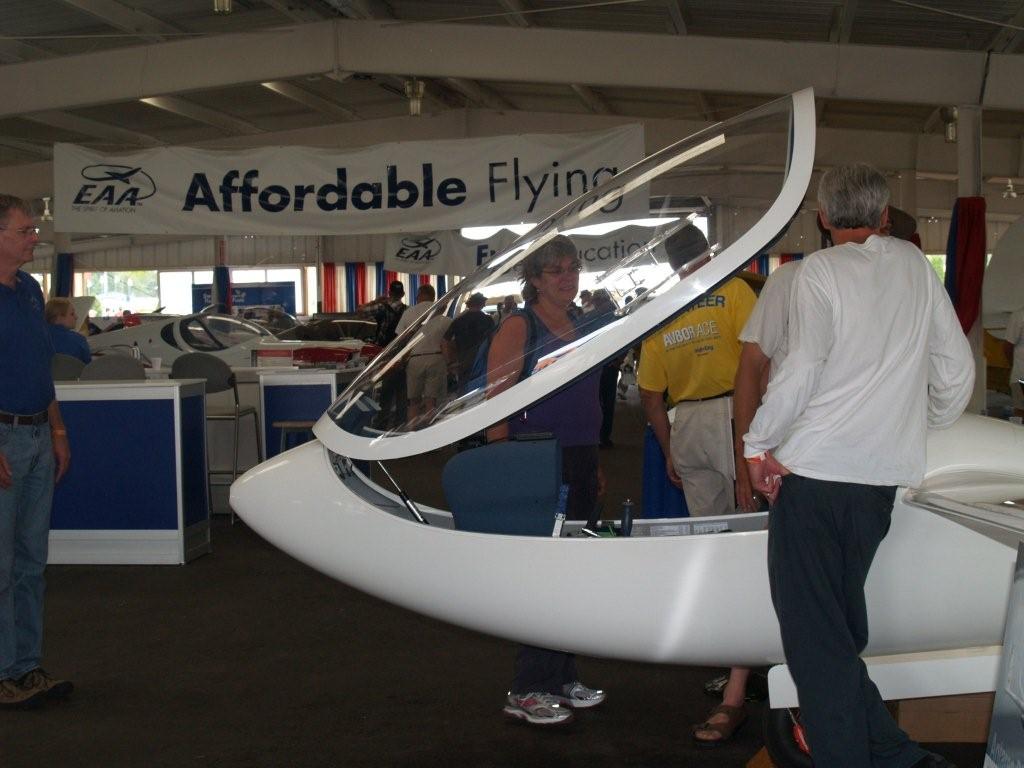
EAA hosted several meetings about electric airplanes, fostering communication amongst advocates, and also trying to understand how EAA can help bring electric technology along. There's much work to be done to get to clear regulations for electrics - certification and safety standards. EAA is well-positioned to help with this and has a long track record of research and government liaison (for example, mogas testing and STCs).
Due to scheduling problems I was only able to attend some of the electric airplane meetings, but they were fascinating. Attendees ranged from dreamers unconcerned about current laws of physics, to folks building real hardware, to Suits in Shades muttering darkly about protecting intellectual property (and we remember how well that worked out for the Wright brothers). The guy on my right at one meeting has 3000 examples of aircraft he designed flying; some of these folks are really heavy hitters.
Electric airplanes have one big problem: batteries. Current battery technology does not provide adequate power-storage per weight to support typical missions of light utility aircraft. In Antares, we need limited power to launch and self-retrieve, when compared to requirements for a typical powered-aircraft flight profile. Batteries continue to improve and hopefully we'll see something practical for airplanes (and not just motor-gliders) in the not-too-distant future.
Given that batteries are the limiting factor, an electric aircraft needs to be very efficient, to get the most out of the limited available power. This means clean airframes, high-aspect ratio wings, and big efficient propellers. The current common power-plane configuration (engine in the nose, relatively small and high-RPM propeller) is an excellent trade-off for a heavy gas engine that likes to turn at high RPM and needs a lot of cooling. This configuration is far from optimum when using a comparatively light electric motor and needing better prop efficiency (big slow propeller). Sticking an electric engine in place of a typical gasoline power-plant doesn't work so well (especially short square wings and short prop). One exhibited electric plane had only about an inch clearance between the prop and the ground - perhaps not the best way to get a larger prop. Clearly its early days yet for electric airplanes, but things are moving forward.
There's a NASA-CAFE challenge for a 100 mpg airplane, with a conversion factor for electric power that makes electric attractive, and this was the focus of much discussion. First place gets $1.5 million prize. Hmmmm...
The Oshkosh airshow is amazingly well organized and extremely safety-focused. I attended the morning safety briefing for several days prior I was scheduled to fly, to make absolutely sure I was clear on procedures, and to arrange logistics for my oversize toy. Saturday dawned with a howling cross-wind for preferred runway 18S. Some scheduled performers with very light wing-loadings pulled out, and others opted for a different runway. "Glider, can you manage this crosswind ?" asked Airboss Mark Ericson. "It will be safe, but not pretty" I answered to everyone's amusement. The Antares manages a cross-wind much more easily than the vintage Wacos some performers were flying ! Taxiing to the runway and back is the biggest trial I face, and with obstacles aplenty and a 20-meter wingspan, I'll stick with 18S.
I wrote a flight narrative to emphasize the sport of Soaring and Soaring as a low-cost entry to flying, as well as to explain the Antares. EAA volunteer Larry Schexnaildre agreed to announce for my flight (all flights must have an announcer), and prepped carefully. Larry does a thoroughly professional job (unfortunately we didn't get a recording of his narration).
At my appointed time I dodged all the obstacles and taxied past the crowd to runway 18S. Blasted off, flicked the switch on the panel to raise the gear, turned back to climb parallel the runway, and was truly amazed by the sight of a quarter-million people below. Stowed the motor and did a high-speed pass at 150 knots (175 mph) and the required 200 feet (unfortunately not dumping water as the logistics of getting water to the flight line were too challenging). Pulled up, went around into a landing approach, then popped the motor back out and climbed away before touch-down. A quick circuit back to land on 18S, bit of a work-out landing with the cross-wind, and promptly got stuck taxiing with a large helicopter obstacle. Got that sorted and taxied back off to the staging area.
The crowd really enjoyed seeing the Antares and were amazed what a glider could do, especially the speed and grace. Its a beautiful sight, and a nice contrast to waves of angrily growling aerobatic machines violently thrashing the air and belching copious smoke. Hopefully many in the audience took away the image of the Antares whooshing by, with the thought they might try Soaring one of these days.
At Sunday's safety briefing I had Gene Soucy on my left and Patty Wagstaff on my right - what's wrong with this picture ;-) At showtime I taxied out to the runway - and someone ground-looped a vintage machine in front of me. The airport was closed while they carted off the debris, and with the limited time my flight was scrubbed - taxi back to the trailer and put it away, aarrgggg. In any case, attendance Sunday was very sparse; I got to fly the busiest day so it worked out well anyway.
Flying the Antares 20E at Oshkosh.
Flight track (OLC overlay on Google Maps), waiting my turn
(in front of Oshkosh Truck armored vehicles on far side of airfield),
175mph fly-by,
climbing away from landing approach.
Photos by Anne Mongiovi and Jeff Phillips.
Click on the images below for a bigger picture...
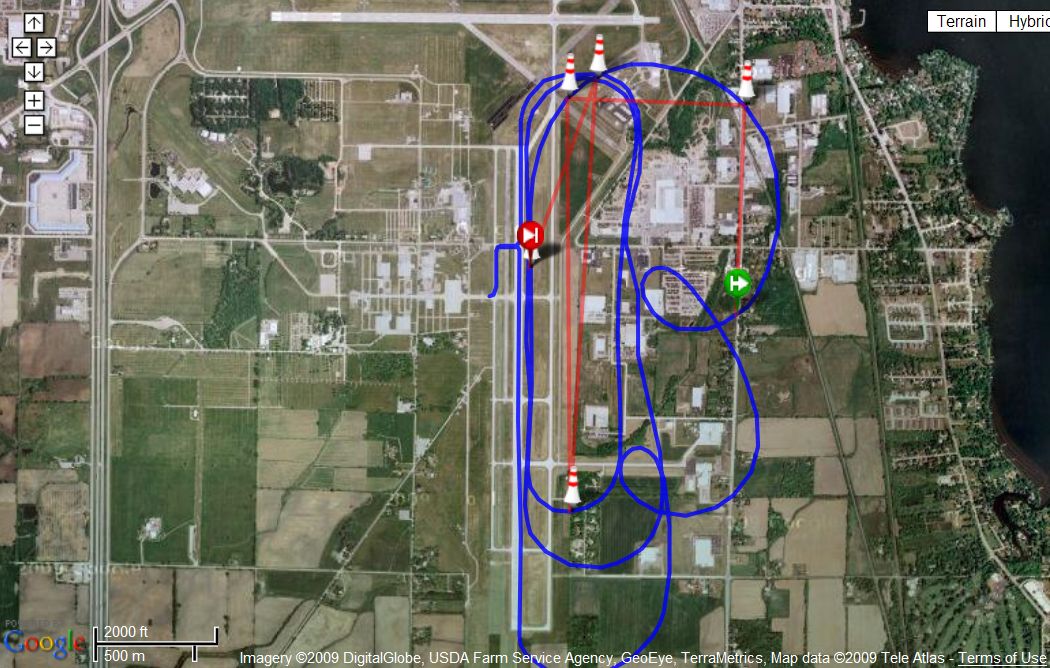
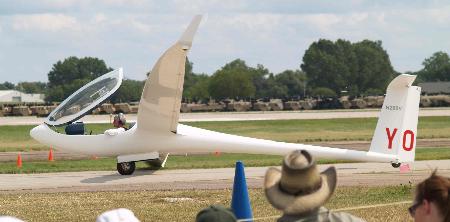
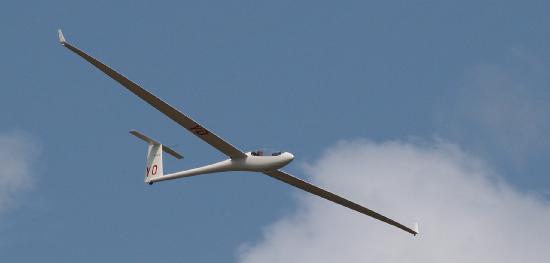
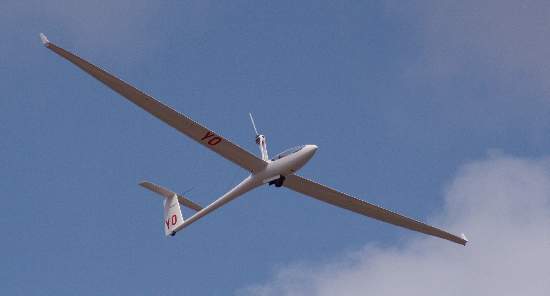
SSA had no formal presence at Oshkosh AirVenture this year, nor was there any coordination of glider presentations for the event, nor was collateral material provided. Regardless, there were at least 7 gliders exhibited including my Antares 20E, a Discus 2 displayed by the US Air Force Academy, Klein Gilhousen's Swift S-1 in the IAC aerobatic area, Bob Carlton's amazing jet-powered Salto flown daily in the airshow, a Stemme S-10 (Bell Aviation), a Super Dimona motorglider exhibited by Diamond, and a Sinus motorglider Pipistrel showed in the Ultralight area.
In prior years, SSA had an official booth at Oshkosh AirVenture, but it was expensive and SSA management felt it did not provide an adequate result for the cost. Not promoting Soaring at Oshkosh more strongly is unfortunate both for Soaring and aviation in general, as Soaring offers a great low-cost entry to aviation (witness all the juniors who started in gliders and are now at the Air Force Academy).
Gliders and SSA Members at Oshkosh
Klein Gilhousen's Swift S-1 at the IAC plaza,
Air Force Academy's Discus 2,
Bob Carlton's jet-powered Salto waiting at the flight line,
Soaring Pilot's dinner organized by Anne.
Photos by Anne Mongiovi.
Click on the images below for a bigger picture...
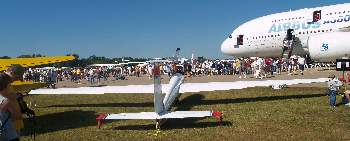
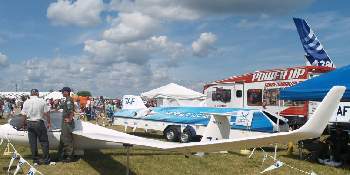

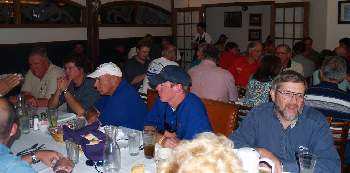
Ron Wagner and Kelly Meyer at EAA (arranged the Aviation Learning Center and invited me), Joe Schumacher of EAA (AirVenture air show mastermind), Mark Ericson (Airboss), Larry Schexnaildre (airshow announcer), Gene Conrad (airshow logistics), Steve Paavola (drove from Massachusetts out to Wisconsin and back with me, and helped many long hours at the display), Anne Mongiovi and her volunteers (printed collateral material, helped at the display, and organized the Soaring Pilot's Dinner), Cheri at SSA and Doug Easton (arranged SSA web site changes for FAST Oshkosh promotional price), John Earlywine (helped with setup and at the display), Al Tyler (matched my contribution for an Oshkosh special FAST price), Juan Mandelbaum (Oshkosh special offer on Juan's movie A Fine Week of Soaring), Richard Gammon (video), Lee Murray and Wes Lineberry (answering questions at the booth), and no doubt dozens of others that I've neglected to mention !
A few thoughts on promoting Soaring...
Hopefully our efforts exhibiting at Oshkosh have benefited Soaring. During AirVenture week SSA sold only 16 FAST introductory packages, which is not much (the web site would not take orders for some of the week, which surely did not help). Regardless, many many people who visited our display said they would check out their local Soaring operation.
Hopefully I'll be invited back next year to exhibit the Antares 20E ! If so, we'll take the additional preparation time to better organize, so we field a better presentation with more people ready and able to promote Soaring and low-cost flying.
Podcast: EAA Radio interviews Dave Nadler at the EAA Aviation Learning Center
Video: Ron Wagner introduces the EAA Aviation Learning Center
Announcer's Flight Narration for Dave's Oshkosh flight
Dick VanGrunsven's article The Year of The Electric Airplane including Oshkosh in the RVator
EAA (Experimental Aircraft Association) Web Site
SSA (Soaring Society of America) Web Site
Dave's 2009 blog from Montague - The USA Open Class Nationals
Antares 20E Electric Motorglider Information
96 year old WASP June Bent flies again in a Duo Discus
June Bent story on front page of Boston Globe, Saturday 10-October-2009
Dave's 2008 Blog from Uvalde USA Open Class Nationals
Dave's 2008 Blog from Mifflin USA 18-meter Nationals
Dave's 2006 Blog from Hobbs USA 18-meter Nationals
Dave's 2005 Blog from Uvalde USA 15-meter Nationals
Dave's 2004 Blog from Uvalde USA 18-meter Nationals
Hope you enjoy this and please email
with questions or comments,
Best Regards, Dave "YO electric"
Dave.Nadler@nadler.com